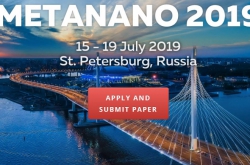Metamaterials, or artificial composite structures, have several unusual electromagnetic properties. For instance, the nonlinear response of metamaterials can be a lot more powerful than that of natural crystals. This property can become crucial for creating fully optical systems of information processing, as addition and subtraction of signal frequencies, as well as controlling the distribution of light is only possible in nonlinear structures.
Still, a fundamental problem arises: how to describe the properties of the electromagnetic response of such materials and optimize the values of their nonlinear properties? This problem drew attention of many researchers. Maxim Gorlach, ITMO's PhD Student and his colleagues conducted a research of the properties of nonlinear metamaterials with regard to spatial dispersion.
 ITMO University. Maxim Gorlach
ITMO University. Maxim Gorlach
"Under particular conditions, spatial dispersion can lead to such events as when a light beam splits into three after falling on the material. Each refracted beam will cause nonlinear polarisation, and we'll have three harmonics with the same frequency, but spreading in different directions. As a result of our work, we've found out that spatial dispersion is especially strong near the resonance point of separate elements in a metamaterial. We also proved that nonlinear susceptibility depends on the direction of the wavevector of the wave relative to the crystallographic axis of the sample. This is absolutely new data. Now we are working on experimental evidence of our predictions", commented Mr. Gorlach.
At the conference in Crete, the report on these results was considered best. Among the jury were the congresses organizers and experts from such journals as Nature Materials and Nature communications, as well as representatives of the World Scientific publishing company. This shows the importance of research on nonlinear metamaterials with regard to spatial dispersion. This year, the conference also focused on the commercialization of inventions based on matematerials research. As of now, there are several companies worldwide that work in that field.
"There already are several promising applications for metamaterials for the microwave band. For instance, ITMO's Research Associate Alexei Slobojanuk develops meta-surfaces for improving the properties of MRT-scanning. His recent results were also presented at the congress. PolinaKapitanova does research on metamaterials' application in wireless power transfer. Also, there was a most interesting report on the use of metamaterials for raising the efficiency of Radio Frequency Identification systems (RFID). Also, metamaterials can be used for optimizing different properties of antennas", shared Maxim Gorlach.
 ITMO University. Center for Nanophotonics and Metamaterials
ITMO University. Center for Nanophotonics and Metamaterials
Other topics were also presented at the conference. Mario Silverinya from the University of Lisbon presented a report on topological effects in photonics. He demonstrated the possibilities of topological effects in continuous systems. This can lead to the creation of wave guides where light won’t dissipate, as well as contribute to technologies for decreasing the size and increasing efficiency of electronic components (you can read about that here). Danish scientist Andrei Lavrinenko shared on experimental research on metamaterials for the visual band and surface waves on the borders of such structures.
The conference gathered scientists from Great Britain, USA, Australia, Russia, Canada and other countries. ITMO's Master's students took part in the poster session of the conference.





